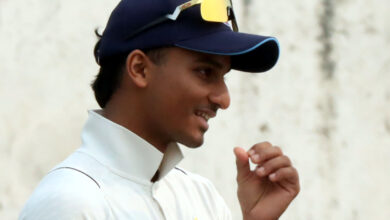Why is Shubman Gill’s Test average not good? ’Rapid sideways trigger and bottom-hand domination’, says WV Raman | Cricket News

Shubman Gill is just a couple of years into his international career, and already understandably is earmarked for higher things as he has established a place in the XI across all formats in the past 12 months. He already has a century in each format, the youngest Indian to the feat. He averages 65.55 in ODIs, 40.40 in T20Is, but in 18 Tests, across varying conditions, he is averaging just 32.20. Even in the Tests against West Indies, where he batted for the first time at No 3, in batting friendly conditions he failed to get beyond 29 in three innings as the worries were slowly adding up in the long format.
WV Raman, former India opener and coach, identifies two aspects that could be dragging the 23-year-old back in the longer format: A rather hurried sideways trigger — that of late he has reworked on to suit him better, and a bottom-hand domination that poses problems, especially against the incoming deliveries. In the past, even while playing at home Kagiso Rabada, James Anderson, and Kyle Jamison have got him with nipbackers across formats. Quite often, there has been a pattern in these dismissals where Gill has got stuck with his trigger movement and late in leaning forward. The weight transfer to the front foot has been slow, and has had him hitting aerial drives to short covers or nicking them behind or combined with other issues, got him into trouble with nipbackers.
The old trigger movement had been an issue since his age-group level, says Raman, who has worked with Gill during his time at the National Cricket Academy in Bengaluru and on away tours with the age-group teams.
“I found he was making too much trigger movement sideways. It was also a bit quick. What could result from it is, you will have real good days and real bad days. On some days the trigger movement will be in sync or bowling will be such that it will help you get runs. And on certain days the movements will be disconnected with what is being required,” Raman told The Indian Express.
Moreover, according to Raman any batsman who is moving quickly in a 900 angle at the crease – sideways to his right- is bound to face problems when the ball darts in.
“When you settle down (after the trigger movement), you will have to have the same balance you had in the stance. You either had to reduce your movement or mask the movement in sync with the bowlers’ run-up or the release. You have to try and work it out yourself to understand what suits you better. What Gill has done off late is he has tried to reduce the movement. He is a lot more still and steady so that he can gauge the length and line better. Because beyond a point, any decent bowler will exploit any chinks in the armour they find in your technique,” Raman said.
Gill has spoken to this newspaper in the past about why he wanted to restrict his sideways trigger movement. “There are one or two important elements. Like your shoulder should be aligned towards the ball, you should be a little side-on while playing, you should be in a good position even if your feet are not moving that well. If you are positioned well in relation to the ball, you will manage… When we play in India, there isn’t that much bounce. Most deliveries stay low. That (reducing the shuffle) was one adjustment I made after talking to our batting coach. I felt I should restrict my initial movement a bit. The ball doesn’t swing much in India either, so the less the movement in your body, the better it will be for you,” Gill had said.
Of late, he has also been choosy in terms of when to have it and not. For instance, during his double-century against New Zealand in an ODI at Hyderabad, the movement didn’t ex when he faced the new ball. Even to the spinners, he stayed rooted at one place before having a slight trigger movement against the pacers.
It is a theme that continued even at the IPL, where he amassed 851 runs for Gujarat Titans. “If a batsman is moving quickly 90 degrees to the bowlers then the problem will be difficult. I believe he has realised it and obviously when you grow as a cricketer, you talk to a lot of people and you get to understand your game better. He will also try things that he wants to try. And that is what perhaps he has done and right now compared to what he was doing, he is almost still. It is good to see him think about his batting and tweak what he has to. These are healthy and encouraging signs,” Raman said.
His issues with deliveries that cut back in sharp – be it against pacers or spinners – continue to ex, though. Raman there are other contributing reasons apart from the trigger movement.
“Lot of batters of late allow the bottom hand to dominate their pick up and down swing. Such batters will struggle against the incoming delivery because primarily their bat will be going across their body, the path of the bat will be a horizontal swing rather than a vertical swing. Let’s say on a clock face, the bat swing will be 10-4. It won’t be 12 to 6. Some will have 11-5, some have 10-4 and in some exaggerated cases between 9-10 and 3-4.
“Bottom hand domination is not going to help you tackle the incoming ball because it will be a case of bat going across the body and the bat face will be closed and there giving minimal chance for bat coming to contact with the ball,” Raman explained.
Raman points out that even the current India coach Rahul Dravid had an issue with his back lift and down swing, but worked a way around it.
“To keep your wr neutral and allow the top hand to dominate everything,” Raman said as to what is the ideal way to overcome this shortcoming. “It is a basic, conventional technique. Some players work it out. For example, Dravid’s back lift and down swing was not a copy book. But his phenomenal temperament helped him. But towards the end of his career when he was repeatedly bowled [in 2012, Australian tour this became a big issue], this was perhaps a problem. You make up for one deficiency with something else. That is the other way out.
“If not, it comes down to keeping the wr neutral and allowing the top hand to dominate. Same thing happened with Harmanpreet (Kaur) when she had the lean phase, and now she has a lot of upper hand domination. Most of the current day batters are bottom hand oriented because they are looking to hit the long ball, rather than play all around the wicket and they prefer one area of the field,” Raman explained. How soon Gill does course correction would determine his immediate future in red-ball cricket.







